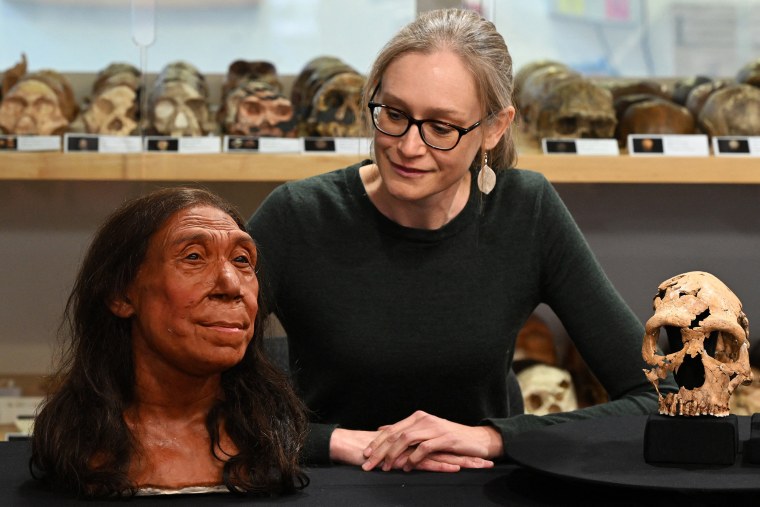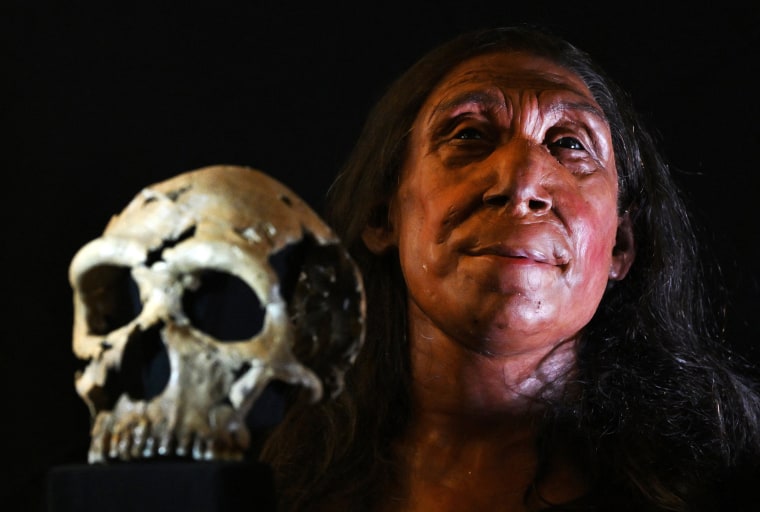LONDON — She looks pretty good for 75,000 years old.
Particularly given that her skull was smashed into 200 pieces, possibly by a rockfall, before scientists meticulously pieced it together over the last six years.
This is Shanidar Z, a Neanderthal woman whose face was re-created by archaeologists at England’s University of Cambridge. Reimagining her facial features, rather than just the skull itself, the university said a report published on its website Thursday, has given experts new insight into what our ancient cousins actually looked like.
Turns out they may have been more similar than we thought — in terms of both their facial features and their thoughts about death.
“The skulls of Neanderthals and humans look very different” to ours, Emma Pomeroy, a paleoanthropologist at Cambridge, said in the report. “Neanderthal skulls have huge brow ridges and lack chins, with a projecting midface that results in more prominent noses. But the recreated face suggests those differences were not so stark in life.”
Given the similarities with humans, “it’s perhaps easier to see how interbreeding occurred between our species,” she added, “to the extent that almost everyone alive today still has Neanderthal DNA.”
Neanderthals were a species of early human that evolved from the same common ancestor as Homo sapiens — modern humans — between 700,000 and 300,000 years ago, according to the Smithsonian. We lived side by side for a time before the Neanderthals died out around 40,000 years ago.
Shorter and stockier than us, they had large noses for humidifying and warming the cold air from the areas they lived in. But their brains were just as large — if not larger when compared in relative size to their smaller bodies.

Shanidar Z was discovered in 2018, one of 10 Neanderthals found in a cave in Iraqi Kurdistan that has become an iconic site for archeologists.
She is “perhaps the best preserved individual to be found this century,” the university said after her face was re-created as part of a documentary, “Secrets of the Neanderthals,” produced by the BBC and released Thursday on Netflix.
The site represents “the most important fieldwork endeavors of modern paleoanthropology,” said Paul Pettitt, a professor of paleolithic archaeology at Durham University, in the north of England. The work settles “the century-old debate as to whether they buried their dead,” he told NBC News.
“We can now say that some Neanderthals buried some of their dead, some of the time,” he added. “We can now proceed to investigate whether burial of the dead was a cultural behavior which, like non-figurative art, varied from region to region, group to group.”
He describes the facial reconstruction as “fun, but hardly of importance” — more of “a focal image for the far more important science that the Shanidar team should be proud of.”
Shanidar Z's skull was flattened and contained 200 bone fragments, which “can be very soft, similar in consistency to a biscuit dunked in tea,” Pomeroy said. The team used glue to strengthen the bones before it removed them in foil-wrapped blocks. Back at the lab, the team diluted the glue, made CT scans of each bone and then began the painstaking process of piecing them back together freehand.
“It’s like a high stakes, 3D jigsaw puzzle,” Pomeroy said. “A single block can take over a fortnight to process.”
The rebuilt skull was scanned again and 3D printed so two world-leading paleoarchaeologists, identical twins Adrie and Alfons Kennis, could begin building up layers of muscle and skin to reveal the face itself. Only half of Shanidar Z was found. So, without her pelvis, the team had to use tooth enamel proteins to determine her sex.
The cave where she was discovered, which is around 50 miles north of the Iraqi city of Erbil, attained legendary status in the field after American archaeologist Ralph Solecki discovered Neanderthal remains there in the 1950s.
The site features a huge vertical rock, which experts say may have been used as a landmark for this burial site — suggesting our relatives may have had a more significant understanding of death than previously thought.
The “persistent use of places in both life and death is a significant Neanderthal trademark — it’s another aspect we share with these ancestors,” said Clive Gamble, an archaeologist at the U.K.’s University of Southampton, who did not take part in the research.
What the study has found “is yet more evidence that many of what we think of as unique human traits originated long before we appeared,” he said.
Cambridge professor Graeme Barker, who led the research, said it should update our image of Neanderthals, who “have had a bad press ever since the first ones were found over 150 years ago.”
He added, “Our discoveries show that the Shanidar Neanderthals may have been thinking about death and its aftermath in ways not so very different from their closest evolutionary cousins — ourselves.”

